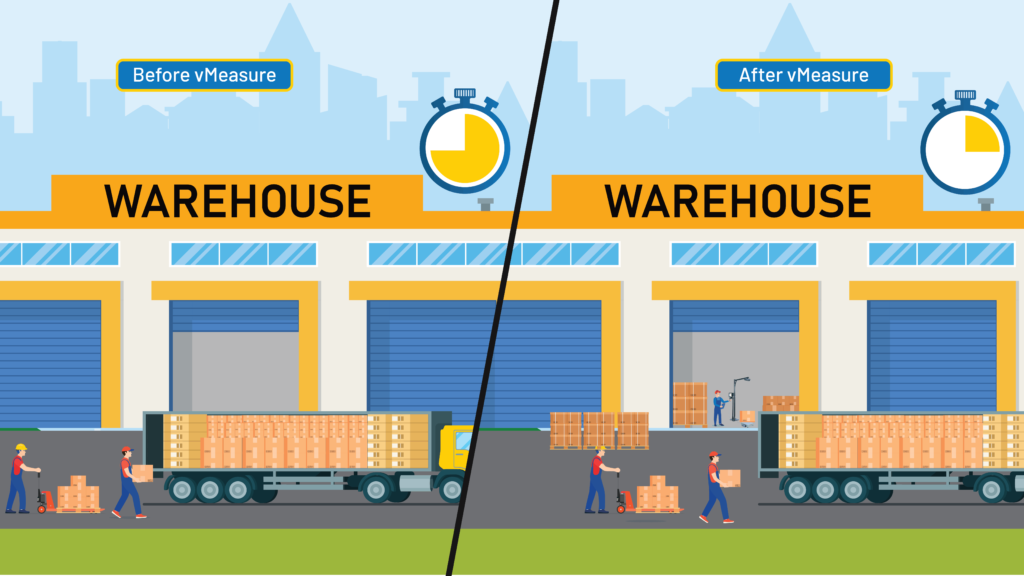Computer vision dimensioner vs Infrared dimensioner
Are you tired of the hassle and inaccuracies of manual dimensioning? The good news is that there are advanced technologies available today that can make this task a breeze. Two of the most popular options on the market are computer vision and infrared technology. But which one is right for you?
In this article, we will delve into the pros and cons of each, helping you make an informed decision for your business. Computer vision dimensioner, with its ability to capture real-time data and provide highly accurate measurements, has gained popularity in recent years.
On the other hand, an infrared dimensioner offers the advantage of being non-contact and can easily measure objects that are difficult to access.
Join us as we explore the intricacies of both these dimensioners, enabling you to choose the right one that suits your needs and takes your business to new heights.
Table of Contents
Understanding computer vision dimensioner
Computer vision dimensioner has taken the world by storm, leveraging the power of artificial intelligence and advanced camera systems to interpret visual information in groundbreaking ways. Whether you’re a novice or a seasoned veteran in the tech world, this guide will break down the critical aspects of this innovative technology. Here’s an easily digestible overview:
Introduction to Computer Vision Technology
- Utilizes a combination of artificial intelligence and camera systems to analyze images or video streams.
- Capable of measuring objects and extracting data with high precision.
- Industries like logistics, retail, and manufacturing have experienced transformative changes due to this technology.
Pros of using computer vision technology for dimensioning
When it comes to dimensioning, computer vision technology can be a game-changer. Here are some significant benefits that make it a compelling choice:
Precision
- Its high accuracy is the standout feature.
- Utilizes advanced algorithms and machine learning techniques to provide incredibly precise measurements with a minimal margin of error.
- Industries like manufacturing and logistics, where exactness is vital, can greatly benefit from this technology.
Versatility
- It offers a one-size-fits-all solution, capable of measuring objects across a spectrum of shapes and sizes.
- The technology is adaptable for a wide variety of applications.
- Whether dimensioning small components or large machinery, computer vision provides consistent and dependable measurements.
Real-Time Data
- It excels at providing real-time data for analysis and decision-making.
- The instantaneous data capture and provision proves invaluable in fast-paced environments requiring quick responses.
- Its ability to provide accurate measurements in real-time allows businesses to streamline processes, reduce errors, and improve overall efficiency.
The utilization of computer vision technology in dimensioning processes can have transformative effects, driving improvements in accuracy, versatility, and efficiency.
Cons of using computer vision technology for dimensioning
While the advantages of computer vision technology are substantial, there are also some downsides that you should consider. Here’s a breakdown of potential challenges when using computer vision for dimensioning:
Lighting Conditions
- Lighting is a critical factor in the effectiveness of computer vision technology.
- In environments with poor or inconsistent lighting, measurement accuracy can be compromised.
- For businesses operating in challenging lighting conditions, this is a significant factor to consider.
High Initial Investment
- Implementing computer vision technology can be intricate.
- It requires investment in hardware, like cameras, and the installation and integration of software with existing infrastructure.
- Initial costs can be high, particularly for smaller businesses.
- Ongoing maintenance and software updates are also important considerations that can contribute to the total cost.
Dependence on Image Quality
- The effectiveness of computer vision technology heavily relies on the quality of images it processes.
- Interferences such as motion blur or occlusion can negatively impact measurement accuracy.
- This can be a significant issue in industries where objects are constantly in motion or situations where occlusion is commonly encountered.
Even though these difficulties may seem overwhelming, you shouldn’t let them stop you from learning more about the advantages of computer vision technology. You may make better plans and make better use of this technology if you are aware of these drawbacks.
Exploring infrared technology for dimensioning
Infrared technology is making waves in the dimensioning world, offering unique advantages compared to traditional measurement methods. If you’re new to this technology or an existing user looking for more insights, this breakdown will give you a clear understanding:
Infrared Technology – The Basics
- Works by utilizing heat signatures for measurements instead of visual data, like in computer vision.
- Detects and analyzes the infrared radiation emitted by objects to provide accurate measurements.
- Does not require physical contact for measurement.
Pros of using infrared technology for dimensioning
Infrared technology is gaining popularity in the dimensioning world, with a host of advantages making it an attractive option. Here’s a rundown of its key benefits:
Non-Contact Measurements
- The non-contact nature of infrared technology allows for measurements from a distance.
- It negates the need for physical contact, thereby decreasing the risk of damage to sensitive or valuable items.
- Particularly advantageous in industries where the preservation of object integrity is crucial.
Accessing Difficult Areas
- Infrared technology effectively addresses hard-to-reach areas.
- In industries such as construction or architecture, infrared dimensioners offer a viable solution for remote or inaccessible structures or components.
- By taking measurements from afar, they streamline the dimensioning process, saving both time and effort.
Real-Time Accuracy
- Infrared dimensioners can provide immediate measurements with high accuracy.
- They capture and analyze heat signatures instantly, delivering precise and current data.
- This allows businesses to make quick, informed decisions, enhancing efficiency and minimizing errors.
- Real-time feedback is especially valuable in fast-paced environments where promptness is key.
These benefits clearly show why infrared technology is a valuable tool for dimensioning, offering a non-contact, efficient, and accurate solution, especially for hard-to-reach areas or delicate items.
Cons of using infrared technology for dimensioning
Considerations for Infrared Technology Drawbacks
- Environmental factors such as ambient temperature, humidity, and air currents can compromise the accuracy of infrared measurements.
- Ensuring accurate measurements requires routine calibration and environmental supervision, potentially demanding extra resources and expertise.
Dependency on Emissivity
- Infrared technology heavily depends on the emissivity of the objects being measured.
- Low-emissivity objects might not give accurate measurements due to the insufficient infrared radiation they emit.
- This limitation can be lessened with calibration standards or coatings with known emissivity values, adding complexity and cost to the dimensioning process.
Challenges with Certain Materials and Complex Geometries
- Infrared dimensioners may have difficulty measuring some materials or objects with complex geometries.
- Transparent or reflective materials may not emit enough infrared radiation for accurate measurements.
- Objects with intricate shapes or irregular surfaces could pose challenges for infrared dimensioners.
These limitations should be considered when deciding on the best dimensioning technology for specific applications.
Objective Comparison: Computer Vision Dimensioner (CVD) Vs. Infrared Dimensioner (IRD)
When it comes to deciding between a computer vision dimensioner and an infrared dimensioner, the choice isn’t always black and white. It’s important to take a deep dive into the key aspects of these two technologies and how they compare on the grounds of accuracy, speed, environment adaptability, integration, and cost.
Accuracy
a computer vision dimensioner and an infrared dimensioner both prioritize accuracy as a crucial element in dimensioning. However, their mechanisms and performance can vary significantly when dealing with different shapes and sizes.
Computer vision dimensioner:
- The standout feature is its use of cameras and 3D depth perception, enabling it to handle various object shapes.
- It can render 3D images of objects, irrespective of their geometry, for measurement with high accuracy.
- Its capability is beneficial when dealing with non-standard, irregular shapes, as it can still compute accurate dimensions despite irregularities.
Infrared Dimensioner:
- Generally, provides accurate measurements but may encounter difficulties with irregularly shaped objects.
- Its main method involves emitting infrared light on the package and measuring the reflection, optimal for flat surfaces or standard-shaped packages.
- For objects with complex shapes or non-uniform surfaces, the infrared dimensioner’s accuracy may be slightly affected.
Speed
Speed is of the essence in a fast-paced logistics or warehouse environment. Let’s compare how a computer vision dimensioner and an infrared dimensioner perform in this aspect.
Infrared Dimensioner:
- The strength of IRD is in its ability to provide real-time measurements.
- Can quickly generate measurements as soon as the infrared beam reflects off the object.
- The almost instantaneous operation makes IRD particularly useful in environments needing high-speed dimensioning, such as conveyor belts or high-volume logistics hubs.
Computer Vision Dimensioner:
- While efficient, CVD may not match the real-time speed of IRD.
- The process of capturing images and creating 3D models can take slightly longer than the infrared reflection method employed by IRD.
- However, the time difference is often insignificant in most operational settings.
Environment Conditions
Both systems have different sensitivity levels to environmental conditions.
Infrared Dimensioner:
- IRD exhibits higher robustness under various environmental conditions.
- Its technology is less affected by lighting conditions, ensuring consistent performance in both bright and dim environments.
- This makes IRD a dependable choice in a variety of operational settings, from well-lit warehouses to darker shipping containers.
Computer Vision Dimensioner:
- CVD systems are more susceptible to changes in lighting conditions due to their reliance on cameras to capture images.
- Lighting variations can potentially affect their performance.
- Nonetheless, most modern CVD systems have features to counter these effects, such as integrated lighting systems or algorithms that adjust for lighting variations.
Integration and Cost
The final elements to consider are ease of integration and cost, which can greatly impact the decision-making process.
Computer Vision Dimensioner:
- Computer vision dimensioners are known for easy integration with existing warehouse management systems or logistics software.
- Often equipped with built-in software interfaces or APIs for seamless integration.
- However, this advanced technology and easy integration usually come at a higher cost, positioning computer vision dimensioner as a premium option.
Infrared Dimensioner:
- Infrared dimensioners are typically more affordable, providing a significant advantage for budget-conscious operations.
- They may have a slightly more complex integration process, potentially requiring more custom coding or hardware setup to interface with existing systems.
- Many suppliers offer support for this process, reducing potential challenges.
To sum up, both computer vision dimensioners and infrared dimensioners have their unique advantages and potential limitations. The choice between them should be guided by your specific operational needs, budget, and integration capabilities.
Factors to consider when choosing between computer vision and infrared technology
When choosing between computer vision and infrared technology for dimensioning, several key factors come into play:
1. Object Types: Consider the type of objects that you’ll be measuring.
2. Industry Needs: Your industry’s specific needs should also be considered.
3. Suitability of Technology: Depending on your needs, the right technology could differ. Computer vision might be more suitable for dealing with transparent or highly reflective objects.
4. Environment Evaluation: Analyze the environment where you plan to use the dimensioning technology.
5. Adequate Lighting: Computer vision technology could be the most appropriate if your environment has consistent and sufficient lighting.
6. Varied Lighting and Other Challenges: If you’re dealing with inconsistent lighting, occlusion, or motion blur, infrared technology might be more reliable.
7. Cost Analysis: Consider the financial implications of your choice, including both the initial investment and ongoing maintenance costs.
8. Budget and Resource Evaluation: By thoroughly analyzing your budget and available resources, you can find the most suitable dimensioning solution for your situation.
9. Future Planning: Consider your future business needs, especially if you anticipate growth or expansion.
10. Scalability: Choose a solution that can easily scale up to meet increasing demand.
11. Integration Capabilities: The chosen solution should be able to integrate smoothly with your existing systems.
12. Compatibility of Technologies: Both computer vision and infrared technology can be part of larger systems or workflows. However, specific requirements and compatibility need to be evaluated.
Taking time to consider these points can guide you toward the right decision for your dimensioning needs, helping you choose a solution that matches your business requirements, environment, budget, and future goals.
Conclusion: Making an informed decision for your dimensioning needs
Choosing between computer vision and infrared dimensioning technologies is crucial for your business operations. Computer vision offers versatility, high precision, and real-time data but requires good lighting. In contrast, infrared technology allows non-contact dimensioning, ideal for fragile or hard-to-reach items and can operate in tough conditions. However, it may need calibration and environmental controls due to dependency on object emissivity. Consider your needs, the items being measured, environmental conditions, budget, and scalability when deciding. Both technologies have proven effective across various sectors and can significantly enhance your operations.
Table of Contents
vMeasure Parcel Ultima
The world’s first and only Dimensioning as a Service (DIMaaS).
The world’s first and only Dimensioning as a Service (DIMaaS).
Dimension everything from an envelope/lipstick to a refrigerator using a single device at the cost of a coffee per day.





